Abstract
Fourteen long term survivors with orthotopic (recipient heart replaced by donor heart) and nine with heterotopic cardiac transplants (recipient heart retained) had 24 hour ambulatory electrocardiographic monitoring to detect ventricular arrhythmias. Arrhythmia was uncommon in the patients with orthotopic transplants; none of them had more than one extrasystole per hour. In the patients with heterotopic cardiac transplants the recipient's own heart showed significantly more frequent ventricular arrhythmias than the corresponding donor heart: abnormal complexes (mean/24 h) 4583 vs 42.7; extrasystoles 1772 vs 17.8; pairs 121 vs 0.8. There was no relation between the abnormal ventricular activity of the two hearts in the patients with heterotopic transplants on a beat by beat, hourly, or 24 hour basis. There was no consistent diurnal variation in the frequency of the abnormal ventricular beats after cardiac transplantation. The occurrence of ventricular arrhythmia was unrelated to the interval from operation to the study. In long term survivors of cardiac transplantation the denervated heart shows a little ventricular ectopic activity even when compared with normal hearts. In patients with heterotopic transplants ventricular arrhythmias commonly occur in the recipient's own heart; these are probably related to the underlying severity of the original disease.
Full text
PDF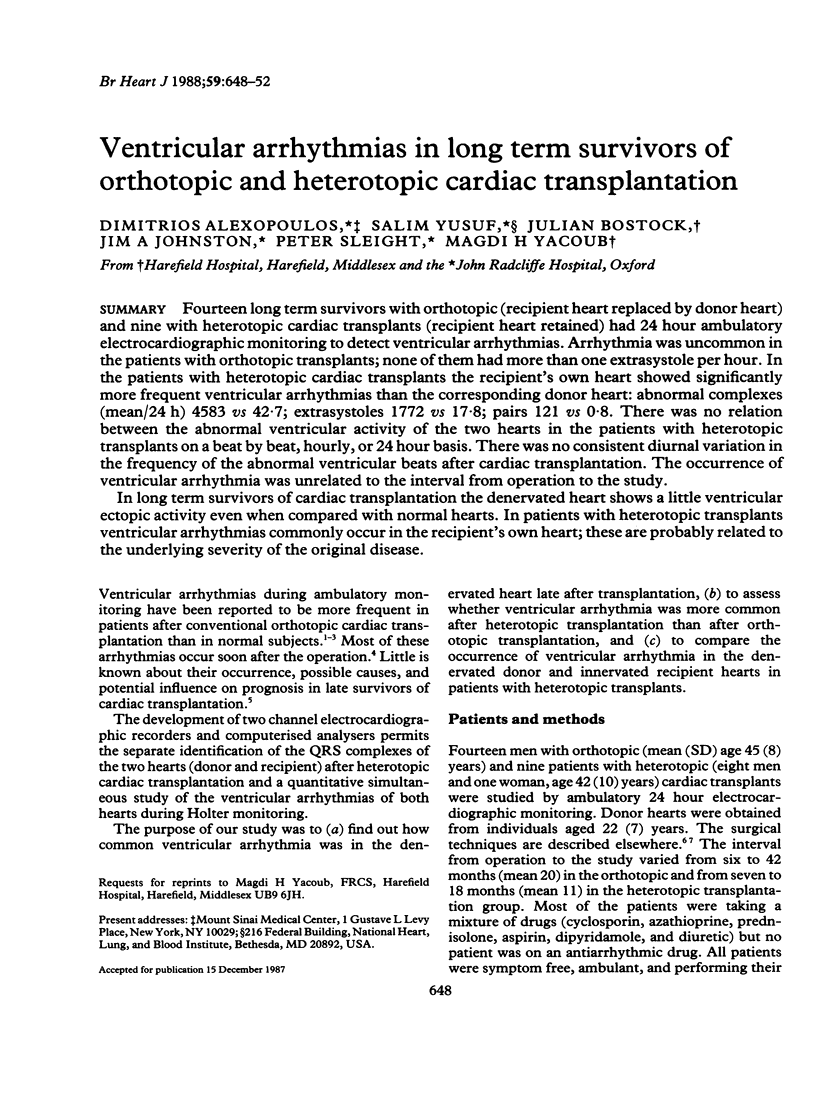
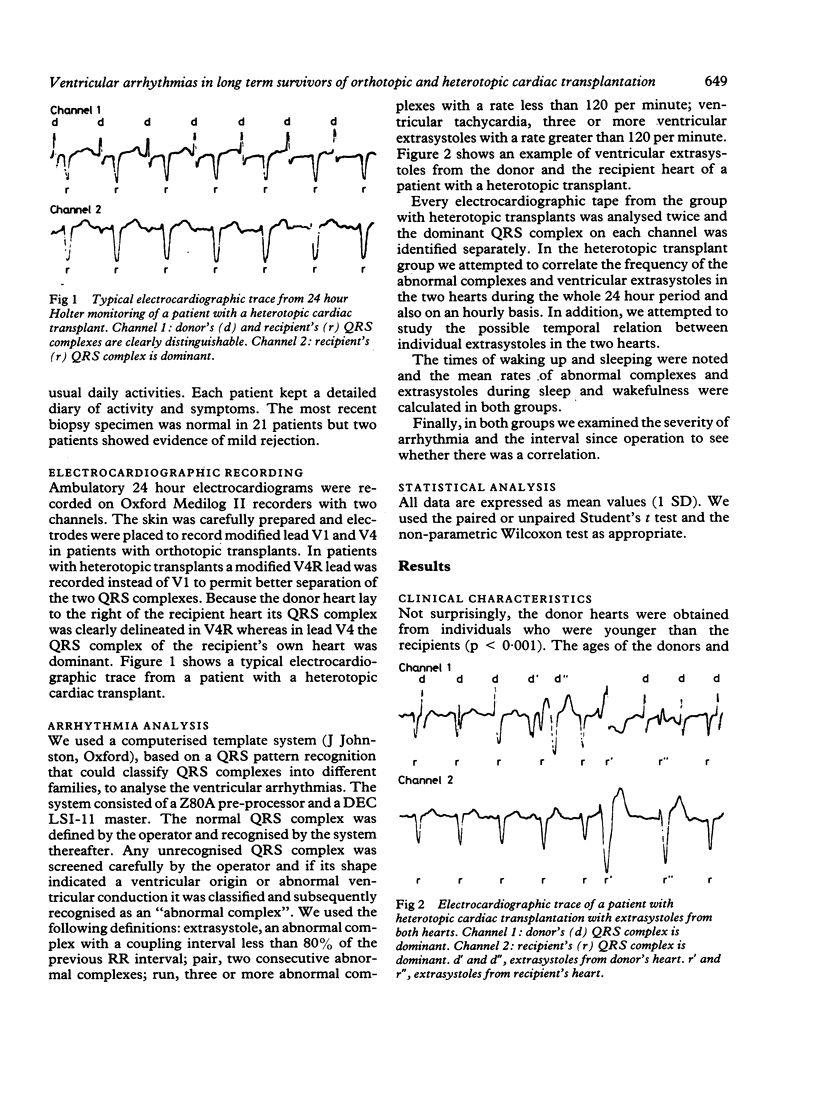
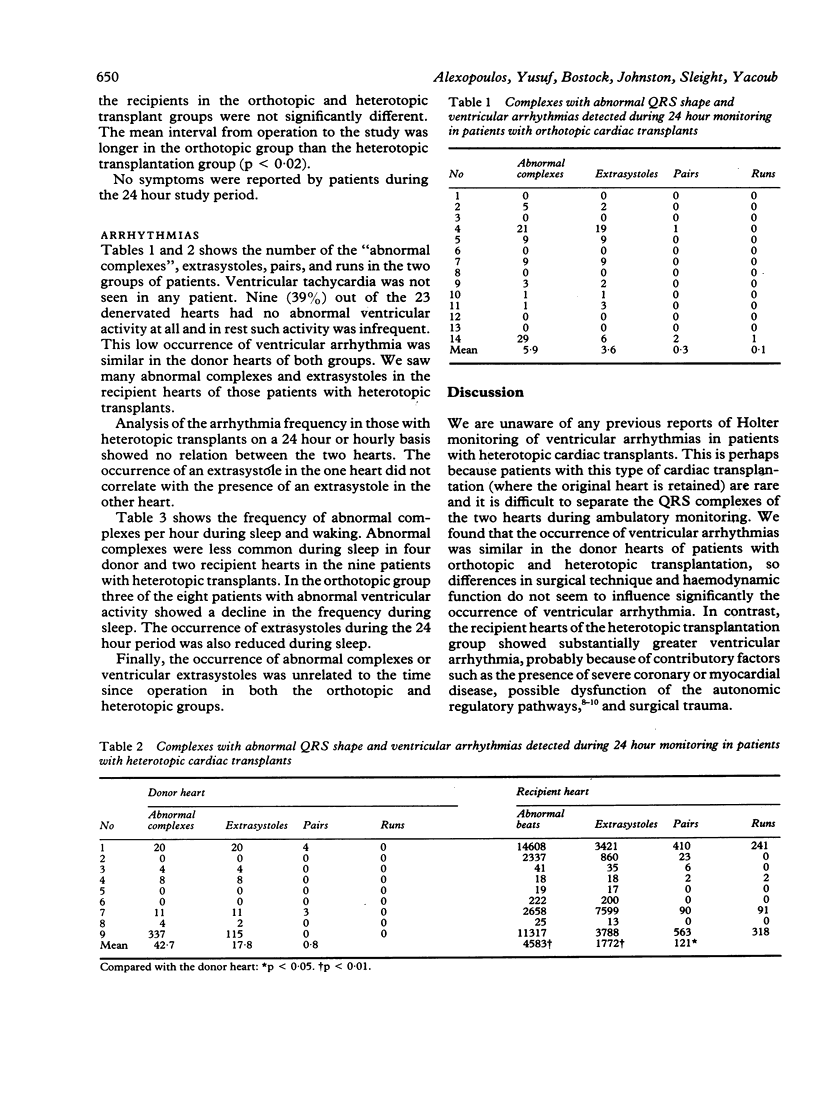
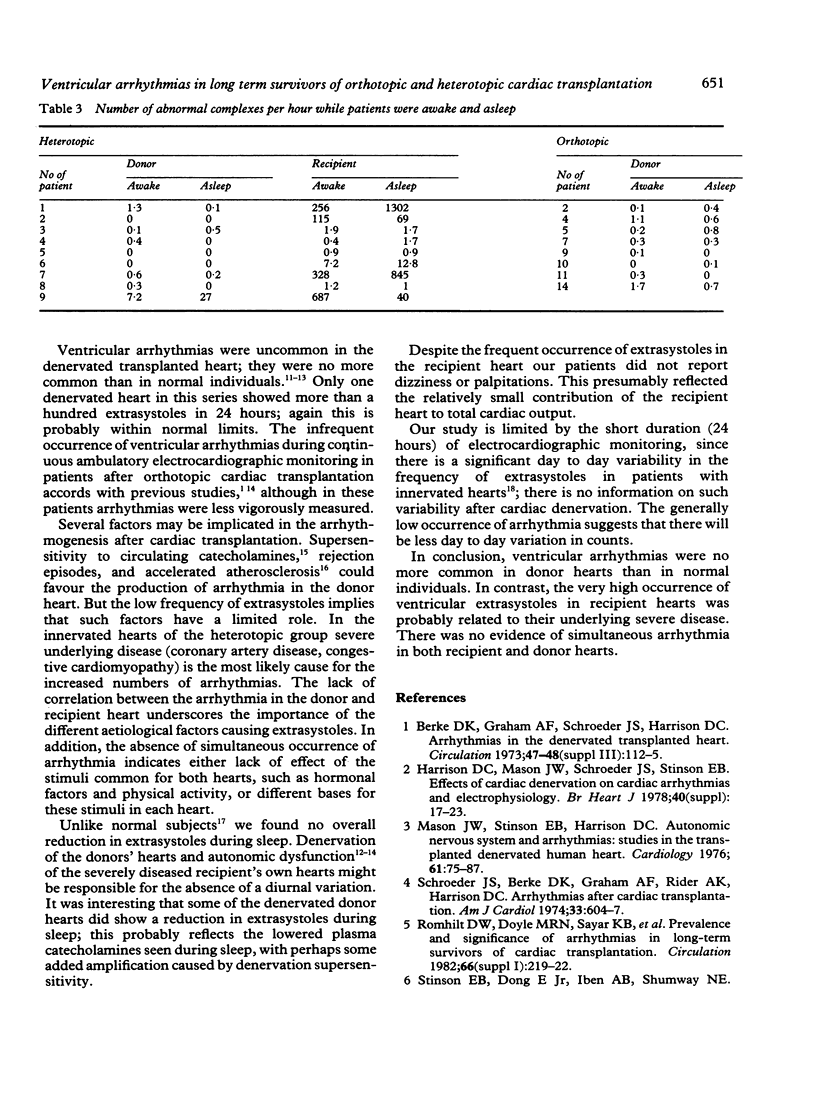
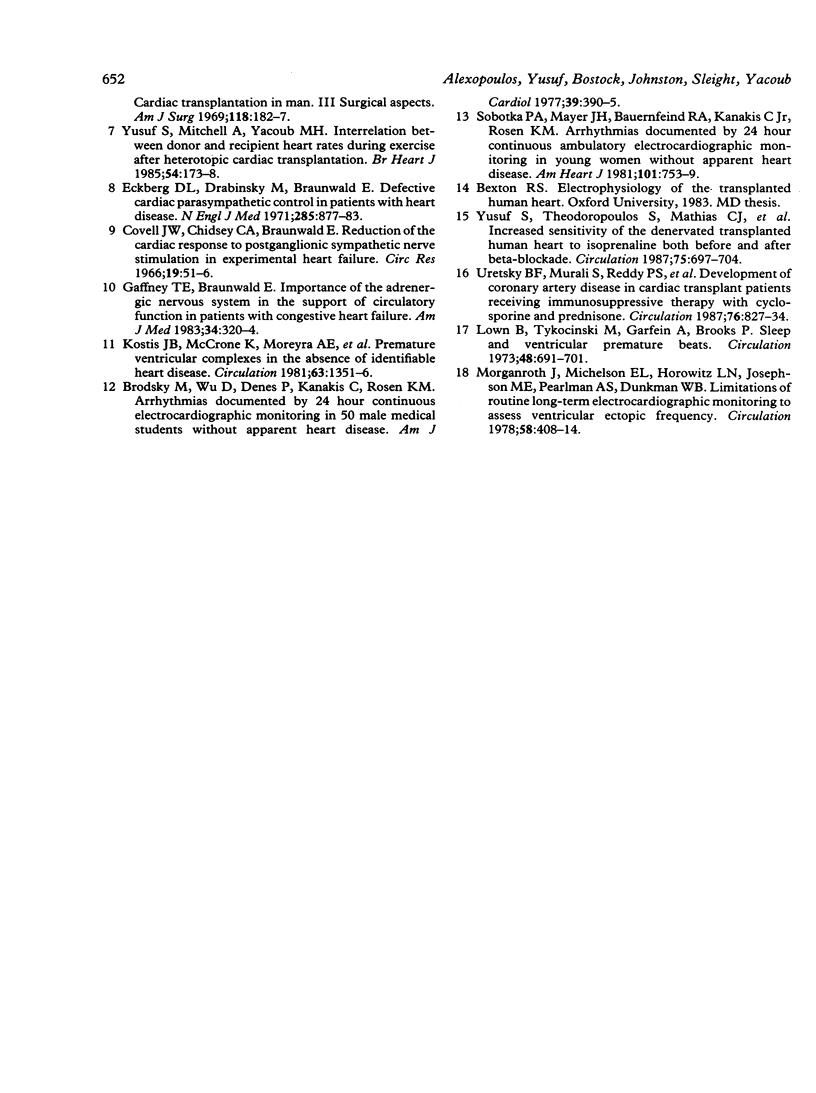
Selected References
These references are in PubMed. This may not be the complete list of references from this article.
- Brodsky M., Wu D., Denes P., Kanakis C., Rosen K. M. Arrhythmias documented by 24 hour continuous electrocardiographic monitoring in 50 male medical students without apparent heart disease. Am J Cardiol. 1977 Mar;39(3):390–395. doi: 10.1016/s0002-9149(77)80094-5. [DOI] [PubMed] [Google Scholar]
- Eckberg D. L., Drabinsky M., Braunwald E. Defective cardiac parasympathetic control in patients with heart disease. N Engl J Med. 1971 Oct 14;285(16):877–883. doi: 10.1056/NEJM197110142851602. [DOI] [PubMed] [Google Scholar]
- GAFFNEY T. E., BRAUNWALD E. Importance of the adrenergic nervous system in the support of circulatory function in patients with congestive heart failure. Am J Med. 1963 Mar;34:320–324. doi: 10.1016/0002-9343(63)90118-9. [DOI] [PubMed] [Google Scholar]
- Kostis J. B., McCrone K., Moreyra A. E., Gotzoyannis S., Aglitz N. M., Natarajan N., Kuo P. T. Premature ventricular complexes in the absence of identifiable heart disease. Circulation. 1981 Jun;63(6):1351–1356. doi: 10.1161/01.cir.63.6.1351. [DOI] [PubMed] [Google Scholar]
- Lown B., Tykocinski M., Garfein A., Brooks P. Sleep and ventricular premature beats. Circulation. 1973 Oct;48(4):691–701. doi: 10.1161/01.cir.48.4.691. [DOI] [PubMed] [Google Scholar]
- Mason J. W., Stinson E. B., Harrison D. C. Autonomic nervous system and arrhythmias: studies in the transplanted denervated human heart. Cardiology. 1976;61(1):75–87. doi: 10.1159/000169749. [DOI] [PubMed] [Google Scholar]
- Morganroth J., Michelson E. L., Horowitz L. N., Josephson M. E., Pearlman A. S., Dunkman W. B. Limitations of routine long-term electrocardiographic monitoring to assess ventricular ectopic frequency. Circulation. 1978 Sep;58(3 Pt 1):408–414. doi: 10.1161/01.cir.58.3.408. [DOI] [PubMed] [Google Scholar]
- Schroeder J. S., Berke D. K., Graham A. F., Rider A. K., Harrison D. C. Arrhythmias after cardiac transplantation. Am J Cardiol. 1974 May 6;33(5):604–607. doi: 10.1016/0002-9149(74)90249-5. [DOI] [PubMed] [Google Scholar]
- Sobotka P. A., Mayer J. H., Bauernfeind R. A., Kanakis C., Jr, Rosen K. M. Arrhythmias documented by 24-hour continuous ambulatory electrocardiographic monitoring in young women without apparent heart disease. Am Heart J. 1981 Jun;101(6):753–759. doi: 10.1016/0002-8703(81)90611-6. [DOI] [PubMed] [Google Scholar]
- Stinson E. B., Dong E., Jr, Iben A. B., Shumway N. E. Cardiac transplantation in man. 3. Surgical aspects. Am J Surg. 1969 Aug;118(2):182–187. doi: 10.1016/0002-9610(69)90118-4. [DOI] [PubMed] [Google Scholar]
- Uretsky B. F., Murali S., Reddy P. S., Rabin B., Lee A., Griffith B. P., Hardesty R. L., Trento A., Bahnson H. T. Development of coronary artery disease in cardiac transplant patients receiving immunosuppressive therapy with cyclosporine and prednisone. Circulation. 1987 Oct;76(4):827–834. doi: 10.1161/01.cir.76.4.827. [DOI] [PubMed] [Google Scholar]
- Yusuf S., Mitchell A., Yacoub M. H. Interrelation between donor and recipient heart rates during exercise after heterotopic cardiac transplantation. Br Heart J. 1985 Aug;54(2):173–178. doi: 10.1136/hrt.54.2.173. [DOI] [PMC free article] [PubMed] [Google Scholar]
- Yusuf S., Theodoropoulos S., Mathias C. J., Dhalla N., Wittes J., Mitchell A., Yacoub M. Increased sensitivity of the denervated transplanted human heart to isoprenaline both before and after beta-adrenergic blockade. Circulation. 1987 Apr;75(4):696–704. doi: 10.1161/01.cir.75.4.696. [DOI] [PubMed] [Google Scholar]


